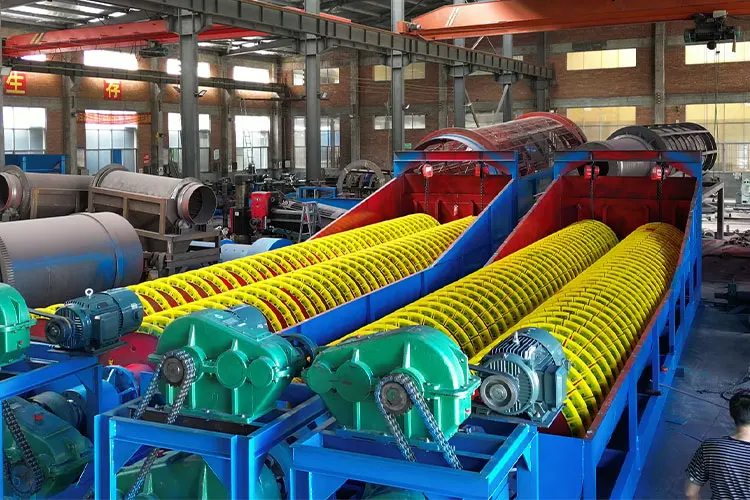Structural composition
Spiral blade: It is the core component of the spiral sand washing machine, which rotates to mix, scrub, and lift sand and gravel materials, pushing them to move in the sink.
Industrial equipment Spiral sand washing machine Spiral blade
Sink: Used to hold sand and gravel materials and water, providing a place for the cleaning process. It is usually made of welded steel plates with a certain slope to facilitate the flow of water and materials.
Industrial equipment spiral sand washing machine sink
Transmission device: including motor, V-belt, reducer, gear, etc., which transmits the power of the motor to the spiral blades to enable them to rotate and work.
Industrial equipment spiral sand washing machine transmission device
Bracket: Supports the weight of the entire spiral sand washing machine, ensuring the stability of the equipment. It is generally made of steel structure and can withstand the vibration and impact force during equipment operation.
Inlet and outlet device: The inlet is used to feed the sand and gravel material to be washed into the water tank, and the outlet is used to discharge the clean sand and gravel after cleaning.
Industrial equipment spiral sand washing machine inlet and outlet device
Device Type
Single spiral sand washing machine: With a relatively simple structure, it is suitable for situations with small processing capacity, small footprint, and low investment cost. It is more suitable for small-scale sand and gravel fields, mines, or construction sites.
Industrial equipment single spiral sand washing machine
Double helix sand washing machine: equipped with two helix bodies working simultaneously, compared to a single helix sand washing machine, it can process more materials per unit time, suitable for situations with high mud content and high production demand. The collaborative work of the two helix bodies allows sand and gravel to be washed more comprehensively and fully in the water tank, resulting in better cleaning effect.
Industrial equipment double helix sand washing machine
Characteristics and advantages
High cleanliness: The stirring and scrubbing effect of spiral blades can effectively remove impurities such as soil and dust on the surface of sand and gravel, resulting in higher quality and lower mud content of the cleaned sand and gravel, which can meet the needs of high-grade materials.
Low power consumption: The power demand for equipment operation is relatively low, and compared to other sand washing equipment, it has a better energy-saving effect and can reduce production costs.
Stable operation: The sealing structure is good, and the fully enclosed transmission device can effectively prevent water and materials from entering key components such as bearings, reduce equipment wear and failure rates, and extend equipment service life. At the same time, the adjustable weir plate can be adjusted according to different production needs to ensure efficient operation of the equipment.
Large processing capacity: Especially the double helix sand washing machine has strong processing capacity and can meet the production requirements of large-scale sand and gravel production lines.
Less loss of washing materials: During the washing process, it can effectively reduce the loss of sand and gravel materials and improve the recovery rate of materials.
application area
Construction industry: used in construction sites, concrete mixing plants, etc., to clean construction sand, remove impurities, improve the quality of sand, and ensure the strength and durability of concrete.
Road and bridge construction: Providing high-quality sand and gravel materials for the construction of roads, railways, and other road bridges can help improve the stability and service life of roads.
Mining industry: In mining, ore is washed, graded, and impurities are removed, which can be used for processing various metallic and non-metallic ores to improve their grade and quality.
Water conservancy and hydropower engineering: used for cleaning sand and gravel materials in water conservancy and hydropower engineering, ensuring that the sand and gravel materials used in the project meet relevant standards, and guaranteeing the quality and safety of the project.


 Spiral sand washing machine-Mining Machinery-Jiangxi Mingxin Metallurgical Equipment Co., Ltd.
Spiral sand washing machine-Mining Machinery-Jiangxi Mingxin Metallurgical Equipment Co., Ltd.